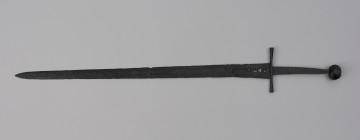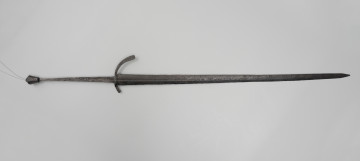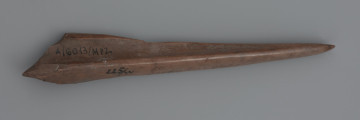
Sword type XIVa J2 (Oakeschott)
1300 — 1450
National Museum in Szczecin
Part of the collection: Militaria
The well-preserved sword with an irregular, polygonal pommel and a cross-guard with quillions curled upwards belongs to a weapon with a grip called one-and-a-half. hand-and-a-half sword. According to the typology proposed by Ewart Oakeshott (1916-2002), the blade of this piece belongs to type XIIIa, which was most widespread in the period 1300-1350. The sword is one of the few in the collection of the National Museum in Szczecin on which inscriptions remain that prove the origin of the object from the collection of the Society for the History and Antiquity of Pomerania in Szczecin (German: Gesellschaft für Pommersche Geschichte und Altertumskunde). Just below the hilt, the number 1238 and the inscription ODER are preserved in red ink, making it possible to determine the origin of this object. The sword was donated to the collection in 1878 by Dr. Prümers. It is known to have been fished out of the Oder River while pulling up anchor. A description of it published in Baltische Studien in 1878 mentions a mark on the blade. Now faintly visible, it was described at the time as a cavalry cross inscribed in two concentric circles. In a study by Marian Głosek (Głosek 1984) this type of mark was considered a likely signature of a swordsman. Given the documented provenance of this weapon, found in the waters close to Szczecin's waterfront, its importance and connection to the city's military history should be highlighted. It is one of the better documented, few examples of surviving weapons used in the Duchy of Pomerania in the early 14th century. Justyna Bądkowska
Author / creator
Object type
longsword
Technique
forging, curving (engraving)
Material
steel, non-ferrous metals
Origin / acquisition method
acquisition
Creation time / dating
Creation / finding place
Owner
Muzeum Narodowe w Szczecinie
Identification number
Location / status

1300 — 1450
National Museum in Szczecin

circa 1390 — 1450
National Museum in Szczecin

9600 p.n.e. — 4100 p.n.e.
National Museum in Szczecin
DISCOVER this TOPIC
Museum of King Jan III's Palace at Wilanów
DISCOVER this PATH
Educational path